#Beat Frequency Oscillator
Explore tagged Tumblr posts
Text
Ham Radio: A Personal Account
by Kevin Gillette
Amateur radio, or ham radio as it is more commonly known, has been a hobby for millions of people around the world for approximately 100 years, give or take. It exists today for much the same reason it came about in the first place: it is (and was) a way for both amateur and professional engineers, tinkerers, physicists and inventors to interact with one another, comparing notes, ideas and innovations that have played a major role in the expansion of telecommunications up to the present day.
This brief memoir is not a history of the hobby, for I came into it only 50 years ago, in 1974. As a result, I don’t have first-hand knowledge of most of what came before. But I can sketch the essentials for you, and with any luck, I will persuade you to see how this hobby can bring a great deal of joy and satisfaction. At the end of this account I will provide some tangible evidence of my days at the helm of a transmitter/receiver/antenna combination over the course of several decades.
First, some preliminaries:
Ham radio began about 100 years ago. The very first enthusiasts used very primitive equipment for both transmission and reception. The earliest transmitters used a technique called spark gap in which the radio signal arose from a spark generated between two electrodes. The frequency of this transmission was dictated by the physics of the electrodes and the gap between them.
For frequency, think of your standard AM and FM broadcast bands, or local television. Radio emission occurs when an electrical field rapidly reverses direction – that is, electrons flow back and forth through a wire or some other device capable of supporting an electromagnetic field. The speed with which this flow of electrons reverses course determines the frequency; the faster the course reversal, the higher the frequency. A single round trip of the electrons is usually referred to as a cycle. Thus, frequency is expressed in cycles per second, or in an equivalent unit, Hertz (one Hertz = one cycle per second). All electromagnetic radiation can be expressed this way. Radiation typically occurs when the flow of electrons alternates direction - electron flow goes by the term current, and so radiation happens with alternating current, or AC. In many (though not all) countries, the electricity that comes out of a wall plug is AC. The opposite of AC is DC - direct current - and this is the case when the electrons always flow the same direction. In essence, DC is zero Hertz AC.
The range of hearing of most humans is between about 60 Hertz (Hz) and roughly 10,000 Hz (this is also indicated as 10 kiloHertz, or 10 KHz). In the United States, the AM broadcast band is from 540 KHz to 1600 KHz (this latter measurement is also expressed as 1.6 megaHertz, or 1.6 MHz). Standard television signals have traditionally begun at 54 MHz, which each television channel occupying a total of 6 MHz. So this means that Channel 2 (for obscure reasons, there is no Channel 1) is from 54 – 60 MHz, channel 3 from 60 – 66 MHz, and so on. There is a break in this pattern for the U.S. FM broadcast band, which lives from 88.0 – 108.0 MHz; the TV channels then continue up to channel 13. The channels 2 through 13 are called the VHF - Very High Frequency - channels. After channel 13 there is another significant frequency gap, after which the UHF, or Ultra High Frequency channels begin, with channel 14.
I’ve mentioned a couple of undefined terms: AM and FM. AM stands for Amplitude Modulation. This was the earliest method used for transmitting sound signals (voice, music, etc). It works by using a central frequency known as the carrier and superimposing an audio frequency on it, resulting in the actual size of the emission varying (at the carrier frequency) according to the audio frequency. This methodology gives rise to what are called sidebands, which cover the frequencies between the carrier frequency plus and minus the audio frequency. This is still used today on the AM broadcast bands in most countries. It is rather wasteful in terms of power, since a lot of the transmitted signal power is in the carrier itself rather than the sidebands where all the good stuff is. For this reason, ham radio operators who do voice transmissions have, since about the 1940s or so, used something called SSB, or single sideband transmission. In this mode, one chooses one of the two sidebands (lower or upper) and suppresses the other one as well as the carrier, meaning that most of the transmitted power goes into the information in the signal rather than being wasted. A more recent form of transmission is FM - Frequency Modulation. In FM transmission, instead of varying the amplitude of the carrier wave as a function of the audio content, the frequency wiggles according to the superimposed audio content. In AM transmission, static and other interference phenomena tend to occur at the peaks of the modulation waveform (see the figure below); with FM, the peaks of the waveform don’t contain information so they can be filtered out, and this gives rise to the notion - largely true - that FM is static-free. Here is an example AM waveform as seen on an oscilloscope:
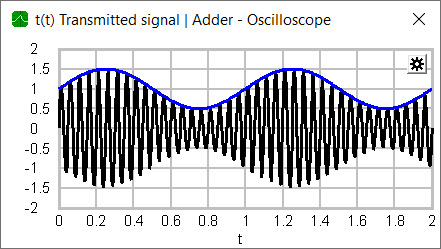
For comparison, here is an example of an FM waveform as seen on an oscilloscope:

In this latter picture, notice how the amplitude of the waveform doesn’t change, but the spacing between the cycles does – this is the wiggle in the frequency I referred to earlier.
I mentioned voice operations in ham radio using a technique called SSB. There are other techniques, especially at the higher frequencies, but I’m not going into those here. I admit that I am something of a purist; I have always preferred to use Morse Code in my ham radio exploits. This is known as CW - Continuous Wave - in the ham radio community. The idea is that to transmit Morse Code, one merely turns a carrier – a continuous wave – on and off with a Morse Code key or something equivalent to it. Speed of transmission is usually expressed in words per minute - wpm. Although the requirement is gone today, in the past, obtaining a ham radio license required the operator to demonstrate at least a basic proficiency in Morse Code, usually somewhere between 5 and 20 wpm. A word in this context is a group of 5 characters and the space after them. I’m proud to say that at my peak, I could listen to – “copy” – transmissions running at about 45 wpm. The world record in those days was somewhere in the neighborhood of 75 wpm, and high-speed code operators in the US Navy and elsewhere typically operated at around 50 wpm, so I was competitive in the CW community as far as speed.
I’ve talked a lot about transmission, but of course it’s all for naught if there’s no way to hear the signal. To do this, one needs a receiver. Receivers are generally much more complicated devices than transmitters – even a modern transmitter can often be constructed with perhaps a dozen discrete parts, including the power supply (or batteries), whereas modern receivers typically need about 10 times that amount in order to be effective and reliable. This is because transmitting is essentially an increasing entropy operation from a thermodynamic perspective, whereas receiving is a decreasing entropy operation, which fights against the tendency toward greater entropy according to the 3rd Law of Thermodynamics. This is much the same as it being a lot easier to generate heat than to remove it from an environment. Receivers are far too complicated to get into here, but I will note that for the kind of work I did – CW and Morse Code – the way the signal could be heard was to tune the receiver to a frequency just slightly to one side of the transmitting carrier frequency and use what’s called a BFO - Beat Frequency Oscillator - to provide a sidetone that represents the difference between the BFO frequency and the carrier frequency. This will be important a bit later, so remember that term.
And of course the ensemble isn’t complete without some kind of antenna. Like both transmitters and receivers, antennas can be everything from a simple piece of wire to a very elaborate contraption that covers a lot of real estate. The rule of thumb is that the higher the frequency, the smaller the antenna needs to be. A very common kind of antenna used on the lower ham radio bands is a vertical antenna, which as the name implies, is a piece of metal (usually aluminum) that is vertically installed. The cable that connects the antenna to the transmitter and receiver is usually attached at the bottom of such an antenna – a picture of such an arrangement appears below:

In this photograph, the antenna has some extra horizontal spokes coming off of it at various points – these are used to suppress capacitance effects of the central pole (the fact that it’s a hollow tube and not an infinitely thin wire causes some of these issues to arise) and to otherwise improve the performance of the antenna.
I haven’t said much about power, so I’ll do so now. Where commercial broadcast stations can transmit at quite high power – varying from 1000 watts to upwards of 100,000 watts – ham radio is restricted to a maximum of 1000 watts for CW and 2000 watts for SSB. I was typically a low-power operator, seldom going above 50 watts and often no more than 10 watts. And yet I was able to make contact with people all over the world on such modest power, so it doesn’t take a lot. An effective antenna system and favorable geography are the primary arbiters of how well one can communicate over long distances.
Something else I mentioned but haven’t yet elaborated on is the licensing process. In the United States, there used to be the following levels of licensing, from the most basic to the most advanced: Novice, Technician, General, Advanced, Extra. I began my ham radio career as a Novice, as everyone did in those days. My radio call sign was WN6FEB (see photo below). To obtain a Novice license, one had to know some basic electronic and radio theory, some basic regulatory stuff (power, bands, on-air protocols, etc) and have mastered Morse Code at 5 wpm. I obtained this license when I was 13 years old. A short time later I upgraded to a General class license and a slightly new call sign, WA6FEB, which extended the radio frequency bands I was permitted to operate on and also extended my maximum output power (as a Novice I was restricted to 100 watts, I think). The General class license required knowledge of more advanced electronics and radio physics, a bit more regulations and Morse Code proficiency of 13 wpm. A few years later I took the plunge and got my Extra class license, which expanded the knowledge base from the previous two licenses and required Morse speed of 20 wpm. As an Extra class ham, I had unlimited access to all internationally agreed-upon ham frequency bands and full power rating. My main motivation in getting the Extra class license was the radio bands – I was never a high-power operator.
My Novice license QSL card (more on this in a moment):
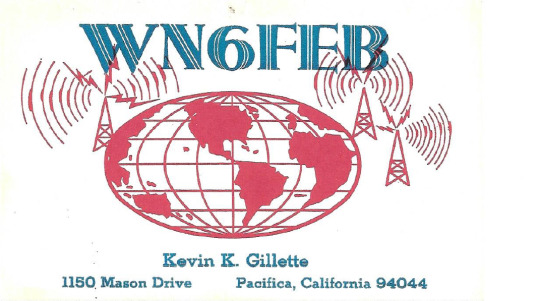
My Extra class license QSL card:
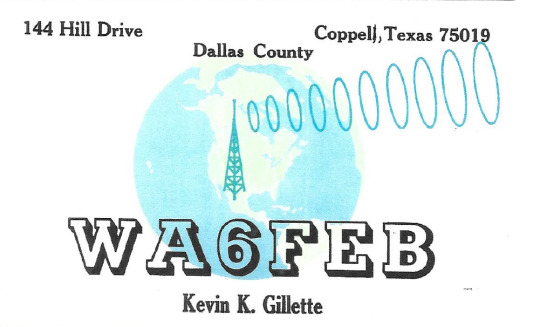
QSL cards are like postcards for hams – we often exchange them to acknowledge that we’ve made contact. They’re often attractive and make great wallpaper or collectibles. I’ve amassed quite a few over the years – there are examples of QSL cards received from around the world at the bottom of this article.
Dovetailing with a previous paragraph, a few words about ham radio frequency bands. Per international agreement, ham radio operators have a large number of radio spectrum segments allocated for their use. It should be noted that in many cases, these allocations are not exclusively for ham radio. One example is the 40-meter band, which covers 7.0 – 7.3 MHz. At least in the 1970s and 1980s, this band featured a lot of non-ham activity, including over-the-horizon radar from the USSR and Voice of America broadcasts from various parts of the world. What made this especially annoying is that the 40-meter band was almost universally open, meaning that effective communication could happen on that band at any time of the day or night, year-round. The Soviet radar sounded like a very loud metronome, and Voice of America was an AM transmission in a segment of the radio spectrum where people didn’t normally use AM, meaning that receivers tuned to this part of the spectrum ended up hearing the carrier as well as the audio signal (which made the audio portion hard to understand). Still, for a young ham radio aficionado hunting for exotic call signs in the ether, it was a lot of fun to wade among the incoherent mass of radio transmissions.
The bands are usually referred to by their approximate wavelength. Recalling that light travels at approximately 300,000,00 meters/second, here is a sample of some of the bands that were popular when I first started back in 1974 (there have been additional bands added to the spectrum since that time; I have no experience on those bands):
HF:
160 meters – 1.8 – 2.0 MHz (I didn’t have any contacts on this band, but my older receiver permitted me to listen in. The antenna requirements for this band are too large for the real estate I had.)
80 meters – 3.5 – 4.0 MHz
40 meters – 7.0 – 7.3 MHz
20 meters – 14.0 – 14.35 MHz
15 meters – 21.0 – 21.45 MHz
10 meters – 28.0 – 29.7 MHz
VHF:
6 meters – 50.0 – 54.0 MHz (note that this is just below the start of the standard television broadcast segment, Channel 2, as noted earlier)
2 meters – 144.0 – 148.0 MHz
I also mentioned the idea of a band being open. On the HF (High Frequency) bands, the propagation of a signal often proceeds in two ways: ground wave and sky wave. Ground wave is exactly as the name implies; the radio signal follows the ground. This signal is of comparatively short distance, perhaps 100 miles or thereabouts. Sky wave is quite a different phenomenon and involves the signal bouncing off of the ionosphere, a layer of our atmosphere that lives between 50 and 600 miles above the Earth’s surface. As the name suggests, this layer contains a lot of ionized particles - mostly from the Sun’s interaction - and it is this layer of ions that forms a sort of reflecting barrier for radio waves below a certain frequency. The highest frequency for which the ionosphere is a reflecting barrier is referred to as the MUF - Maximum Usable Frequency. Above this frequency, radio transmissions pass through the ionosphere and out into space. When a band is open, that means that the MUF is greater than the band’s frequency, at least as an approximation. The 40-meter band is virtually always below the MUF, meaning that it’s open all of the time. This is what makes it so popular. The 20-meter band is often (though not always) open, which is what makes it a premium band for long distance communications, referred to in ham radio parlance as DX (which stands for distance). The 20-meter band has the advantage that it is strictly for ham radio – no competing services cause interference and noise. When an HF band is open, the sky wave mode of signal propagation is also referred to as skip, meaning that the signal will skip off of the ionosphere, sometimes multiple times – this makes for worldwide transmission and reception.
You may be asking yourself what was in it for me, that I would have such fervor for a hobby that is admittedly declining in popularity (with the advent of email and the Internet). I think a simple anecdote will make it clear:
When I was about 15 years old, early in my ham radio career, I lived in a small town near San Francisco and also near Stanford University. I had an on-air friend named David Gray, WB6ZMJ, who was a graduate student in geophysics at Stanford. David was a member of the Stanford Amateur Radio Club (SARC):
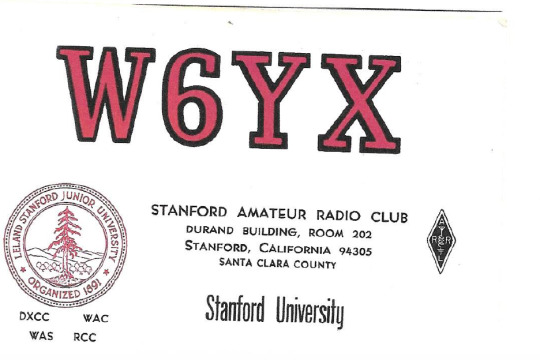
One weekend he invited me down to Stanford to participate in what is known as moonbounce. In moonbounce, hams from across the globe will transmit on the VHF frequencies directly up to the Moon, bouncing their signal off the Moon to be received somewhere else on the planet. Recall what I mentioned above about the MUF; the VHF frequencies are all well above the MUF, so VHF signals cannot participate in the skip mode of propagation (except under some very unusual circumstances). Stanford University has an enormous radio telescope, affectionately referred to as The Dish, that sits on a small hill on the SW side of campus. A picture of it appears below. The Dish is about 150 feet across and was built in 1961. It remains in use to this day. The SARC used The Dish as their antenna for moonbounce activity.
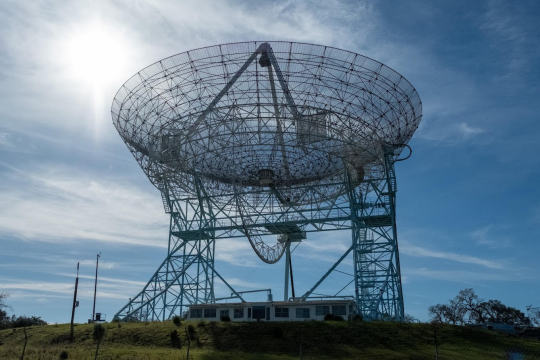
Here's the rub: The path length from Earth – Moon – Earth (EME) is about 500,000 miles. The loss in signal strength approaches 250 dB, which equates to dropping from a Formula 1 roar down to the tiniest of whispers. In fact, the signal strength is so low that even when using CW, the signal isn’t strong enough to trigger a BFO for a sidetone in order to read the signal. The only way to hear the signal is to listen for quiet spots in the background noise! That’s where I came in on this particular occasion. I have (and have always had) exceptionally acute high-frequency hearing, and so what sounded like white noise to the grad students in the SARC was an intelligible signal to me. So, in the middle of the night, there I was, in the metal housing seen at the base of The Dish, listening to a mysterious CW signal from a ham in Sweden coming by way of deep space, and writing down what I heard. For a lonely, nerdy kid, this was the height of affirmation – it was OK to be nerdy and science-oriented when you got to play with such exotic toys! Indeed, not only did this experience cement my desire to pursue ham radio; it also confirmed that Stanford was the place I wanted to pursue my university studies (as indeed I did, graduating with a Bachelor’s degree in applied mathematics and a Master’s degree in operations research, all before my 21st birthday).
In the years following graduation from Stanford, I got married and moved to Dallas, Texas, where once we purchased our first home, I immediately set up a nice ham shack in the laundry room. I made tons of great contacts all over the world with the most modest of equipment (alas, I don’t have any photos of my gear from those days). When we started our family, the hobby had to take a back seat, and eventually I let my license lapse. But now that I am approaching retirement age, I long once more to get back on the air and hunt for those mysterious signals beaming in from everywhere.
Kevin Gillette, 26 January 2024
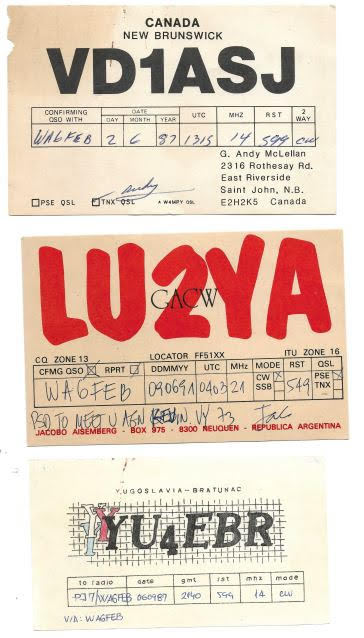


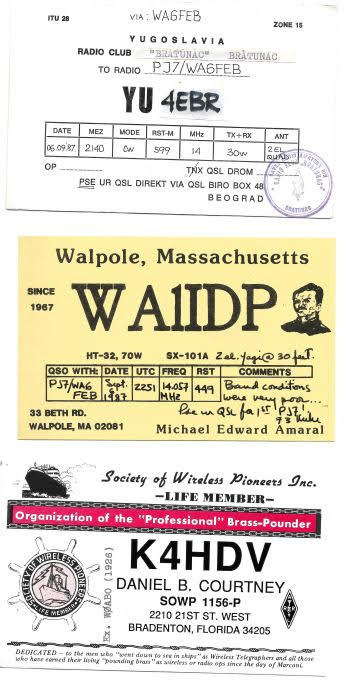
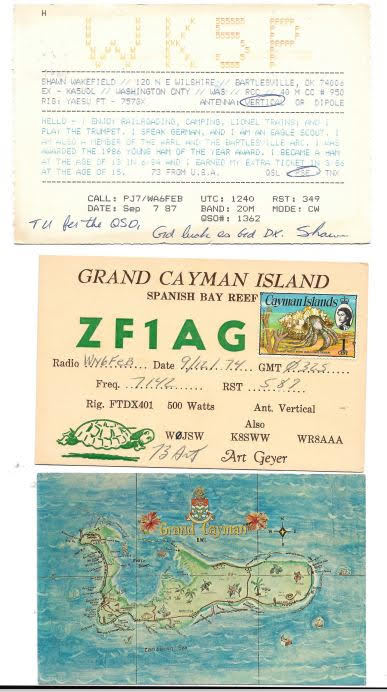
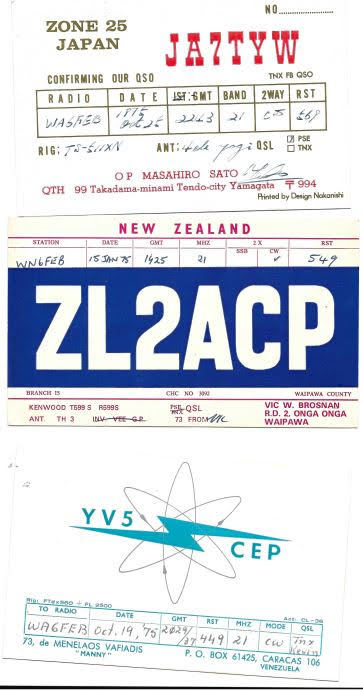
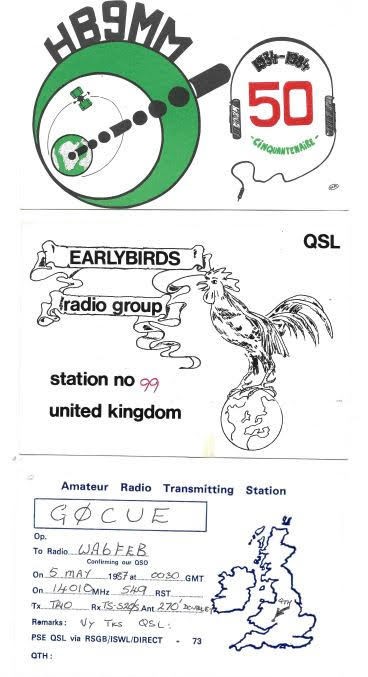
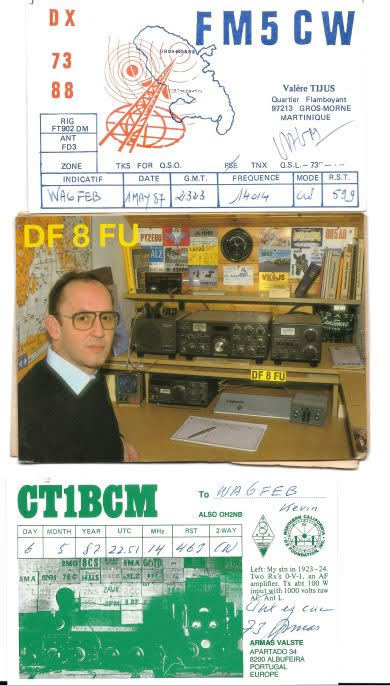

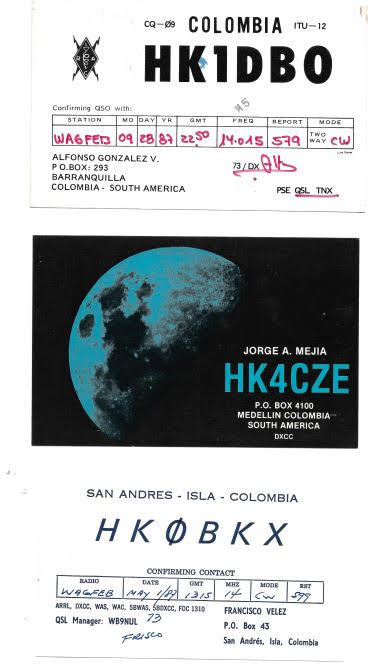
Image credits : Images in the text with thanks to © respective creators and publishers. QSL Cards at end of article above received by author, with thanks to © respective creators
Kevin Gillette
Words Across Time
26 January 2024
wordsacrosstime
#Words Across Time#Kevin Gillette#wordsacrosstime#January 2024#Amateur Radio#Ham Radio#Broadcast Bands#Electromagnetic Field#Stanford Amateur Radio Club#Beat Frequency Oscillator#US Navy#Morse Code#SSB#AM#FM#Maximum Usable Frequency#Sidetone#Sidebands#Continuous Wave#Antenna#Spark Gap#Hobby#Tinkerers#Inventors#Telecommunications#VHF#Frequency Modulation#Amplitude Modulation#Alternating Current#Direct Current
1 note
·
View note
Note
When me and my friends were young (but not that young) our small hometown town somehow got the money to build a 1000ft long pedestrian suspension bridge. We were bored and found that if we grabbed the suspension cable at its lowest point and pushed and pulled it at the right frequency we could slowly build up oscillations in the bridge. You could feel the walkway swaying underneath us and see the movement in the main suspension cable. We would do this with several people with one person counting out the beat until the oscillations got so large that the suspenders attaching the walk way to the main cable started to slam into the hand rail and make a horrible clanging noise. Then we would all be scared, and no longer bored so we would stop.
While doing this I was aware of the differential equations describing first and second order resonance in elastic structures with and without dampening. I had studied several engineering disasters where cyclic loading close to some multiple of the resonance frequency lead to collapse of buildings and bridges. It is a small town and I was bored.
I am bad at transitions, and I would like to ask for advice/articulate something. Mostly to force myself to articulate thoughts I have never spoken about, and you do not have to read all this. Because it is very long and large parts of it are honestly pretty horrible. I have for some time been making a very conscious effort to not think about "my gender". Because I felt that there would be no use in thinking about myself through that lens. Telling myself that I can do whatever I want regardless of gender. This seemed to work for me except I find myself paralyzed. I cannot imagine myself in a romantic or sexual relationship. Romantic or sexual attention I receive feels like it is intended for somebody else. Even in situations that should be simple where attraction is mutual I feel confused and conflicted. As I write this I am wearing clothes somebody gave to me almost a decade ago, they have holes in them and I never really considered what they look like to other people. A couple times a year when I make budget or apply for a job etc I thin about the future but only ever a year or two ahead. This future blindness gets so bad I often can't even make plans for the weekend. I find myself looking at my reflection as if trying to find something wrong with my appearance but I couldn't put my finger on any specific flaw. I look like an attractive man, what else could I ask for.
I have recently allowed myself to think about this and I am not sure that it is helping. I realize now that being a man can be an exhausting constant effort for me, and that certain things that I have been doing can alleviate this pressure. When I wear my long hair down, I do not imagine that I have become a women, but the act of wearing my long hair down and shaving my entire face is not something I would do to look like the manliest man. This almost symbolic rejection of my internal drive to act as a man has a profound effect on me. Especially when I am alone I find this very calming, my mind is a little quieter, my breathing is a little deeper.
However in public this is often over shadowed by a new discomfort. My already ever present sense of danger in public is heightened. Around many men I feel physically unsafe, as if a threat of violence lies just under the surface of every interaction. Around women my discomfort around men and with myself seem to combine and I cannot shake the feeling that I will make them feel unsafe. Making women feel unsafe makes me unsafe and so on. All this is worse the more feminine I am.
My small symbolic gestures of femininity in private would seem to have no real downside. Their benefits seem to come into effect as soon as stop trying to look masculine. However in the perception of others I feel a pressure to appear either completely man or women. I now find myself trying to appear feminine and this might be worse. Outside perception of me feels completely beyond my control. Which is a good excuse for me to repress any thoughts or feelings about it. I want to accept that this is outside my control, and also that I desperately want to control it.
Some of things I believe about this view of me from the outside are not things I would ever want to put on anyone else. I have never seen a person that would look worse with some musculature, and have always found strong people aesthetically pleasing and attractive. I enjoy being strong, it practical utility, the sense of security it provides me, and as an accomplishment I am proud of. Yet at the same time I sometimes find myself revolted by my muscles. My size, my veins, my bones, nothing about them is wrong except that they are there.
I feel I need to juxtapose any feminine attributes against my masculine ones (one earring is allowed but with short hair. Long hair is allowed in a bun but with stubble). To appear as a feminine man and not a failed attempt at manliness. Is this my reaction to a societal pressure or my own misandry against weak men? I have no way of knowing. Similarly I feel that the only way to be extremely feminine or a woman would be to subject myself to sexual objectification, and infantilization ("femboys" are only feminine as long as they are somebodies fetish and because they are boys and not adults). Again I cannot say if this is my reaction to a societal trend or my own judgement on other people. Either way I cannot help but feel that this pedophilic degrading view of femininity and women is a moral sin I have committed. Yet what possible use could there be in applying a moral judgement on my own thoughts? I don't choose to feel or think these things. I don't want to wear booty shorts, or dress up like a princess. Do I think less of those who do? If don't subject myself to this degradation in exchange for femininity will it be because I have the self respect of a man? Or is it just cowardice.
I don't want to look like a trans women. I want what my grandma has. She is a matriarch. The varicose veins on her arms, her short hair, a raspy laugh, a double mastectomy, these things are just the type of women she is. She is a mother of mothers. She might not be asked to pray over the meal, but her wisdom is an open secret among those that are really looking for ruthlessly honest advice. She must enjoy wearing jewelry (or she wouldn't bother) but never seems to take it too seriously. When telling a story about how she fought a bear off her daughters or cracking a joke about how she will die any day now her womanhood is so effortless, so inconsequential, so in the background that it almost seems almost useless.
oh my fucking god lady just take the fucking estrogen
136 notes
·
View notes
Text

The question that finally began to coalesce in my mind, and which finally took on a coherent form like a star igniting at the center of a long-contracting stellar nebula, was this: Are Drinky Bird's oscillations regular enough to allow you to use them as the basis for a clock?
[...]
The basic mechanism was invented in Germany in the mid-18th century but its incarnation as we know it comes later and such a toy seems to have been first described by the Soviet physicist Yakov Perelman, in the 1930s, who was also the author of the optimistically entitled Physics Can Be Fun and Mathematics Can Be Fun. He called the toy the "insatiable birdie" (and if anyone can tell me in the comments what Russian phrase can plausibly be translated as "insatiable birdie" I will die a happy man, or at least, less unhappy). Perelman said of the Insatiable Birdie, in Physics For Entertainment, "There is a Chinese toy which is a perpetual source of astonishment and delight. This is the 'insatiable birdie.' Put before a drinking bowl, the 'birdie' will dip its beak in the water and having 'drunk its fill,' swing back into its initial upright position."
[...]
The basic problem is that the period of Drinky Bird's oscillations is extremely sensitive to external conditions – the study cites ambient temperature and humidity (which affect the rate at which the head cools) the amount of water on the head (ditto) mechanical friction and even the force with which the Bird hits the lip of the bowl or cup containing water. The period of oscillations in general seems to stabilize, everything else being equal, to around 30-40 seconds but unlike a balance spring or pendulum, Drinky Bird is not a harmonic oscillator. The qualification for a harmonic oscillator is that when it is displaced from its neutral point, it experiences a restoring force proportional to the displacing force (the spring tension in a balance spring; gravity in a pendulum).
Drinky Bird is, like the Atmos clock, a heat engine but in the Atmos clock the expansion and contraction of the gas-filled chamber that powers the clock is used to wind a mainspring, which drives the horizontal, very slow-beating balance (technically a torsion pendulum). You can use temperature changes to drive a wristwatch as well. In 2002 an American watchmaker and AHCI member named Stephen Phillips introduced his EWS – Eternal Winding System – in which temperature fluctuations affected a bimetallic strip, causing it to flex and keep the mainspring wound. Unfortunately the system has, so far, not found its way into a working watch.
However, what Drinky Bird lacks in natural frequency, it gains back in apparent longevity. Drinky Bird will not bob forever but it could do so for an almost absurdly long time under the right conditions. I should note here that Drinky Bird is not a perpetual motion machine – such devices are forbidden by the Second Law Of Thermodynamics. The ability of DB to bob is dependent on a temperature difference between the upper and lower part of the internal tubing and as long as there is an external temperature gradient that allows evaporation, and a supply of water, it will bob happily along.
One must imagine Drinky Bird happy.
20 notes
·
View notes
Text
14 November 1969
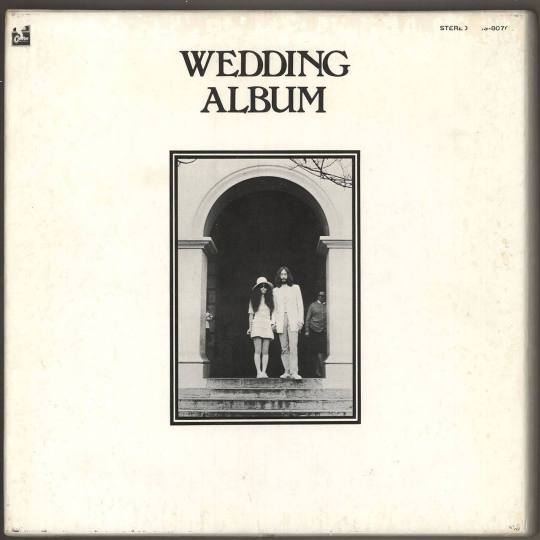
On this date, John and Yoko's third LP is released. Having been sent a promotional copy with two discs, with a test signal on one side of each, Melody Maker reviewer Richard Williams gamely listens to what he thinks is an intentional release, concluding:
...constant listening reveals a curious point: the pitch of the tones alters frequency, but only by microtones or, at most, a semitone. This oscillation produces an almost subliminal, uneven ‘beat’ which maintains interest. On a more basic level, you could have a ball by improvising your very own raga, plainsong, or even Gaelic mouth music against the drone.
Lennon and Ono replied by telegram:
DEAR RICHARD THANK YOU FOR YOUR FANTASTIC REVIEW ON OUR WEDDING ALBUM INCLUDING C-AND-D SIDES STOP WE ARE CONSIDERING IT FOR OUR NEXT RELEASE STOP MAYBE YOU ARE RIGHT IN SAYING THAT THEY ARE THE BEST SIDES STOP WE BOTH FEEL THAT THIS IS THE FIRST TIME A CRITIC TOPPED THE ARTIST STOP WE ARE NOT JOKING STOP LOVE AND PEACE STOP JOHN AND YOKO LENNON
66 notes
·
View notes
Text
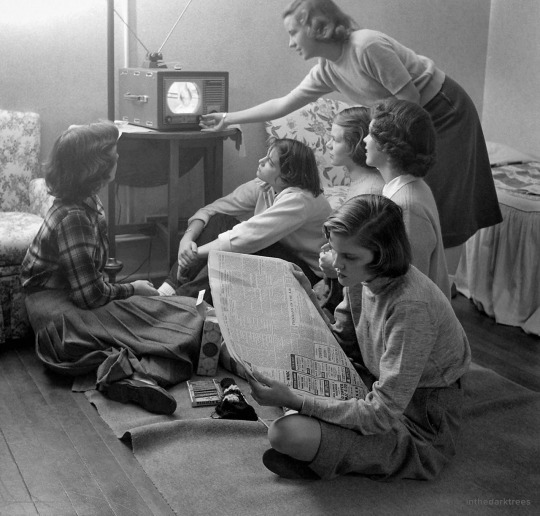
by Nina Leen, 1949
* * * *
We huge many-celled creatures have to coordinate millions of different oscillation frequencies, and interactions among frequencies, in our bodies and our environment. Most of the coordination is effected by synchronising the pulses, by getting the beats into a master rhythm, by entrainment… Being in sync—internally and with your environment—makes life easy.
Getting out of sync is always uncomfortable or disastrous. Then there are the rhythms of other human beings. Like the two pendulums, though through more complex processes, two people together can mutually phase-lock. Successful human relationship involves entrainment—getting in sync. If it doesn’t, the relationship is either uncomfortable or disastrous…
Listening is not a reaction, it is a connection. Listening to a conversation or a story, we don’t so much respond as join in—become part of the action.
— Ursula K. Le Guin, “Telling is Listening”, in "The Wave in the Mind: Talks and Essays on the Writer, the Reader, and the Imagination"
[slow roots] [via “Alive On All Channels”]
28 notes
·
View notes
Text
Sébastien Roux — Les disparitions (Insub)

French musician Sébastien Roux is an inveterate sonic explorer, utilizing an engineering background in computer signal processing to develop compositions, multi-channel sound installations, radio pieces and site-specific performances. Over the course of the last 20 years, he has released recordings like More Songs and Quatuor which use the individual parts of Beethoven’s “String Quartet No. 10” as the basis for an electroacoustic exploration of form and timbre. Inevitable Music #5 is a sonic translation of Sol Lewitt’s instructions for wall drawings composed for the Dedalus Ensemble while Musiques D'ordinateur is computer music developed from formal investigations into algorithmic procedures. Roux’s most recent release, Les disparitions (the disappearances) is a series of studies for viola, voice, cello and electronics which delve into the nature of sound and its decay; how does sound disappear and how does one perceive that departure?
Over the course of eight pieces, the composer uses verbal scores which “oscillate between actions to be performed and descriptions of a sound or a state of consciousness to be produced.” The ensemble (violist Cyprien Busolini, vocalist Yannick Guédon, Roux employing electronics, and cellist Deborah Walker) are deployed in a variety of combinations for these sonic explorations. Over the course of 11 minutes on “dans le silence” (in silence), the quartet voices a chord and then lets it slowly wane, exposing overtones and timbral vacillations as memory gradually fills in the disappearing fundamentals. Figure and ground are the building blocks of “la figure et le fond,” with sustained vocal tones shadowed by subtle string textures. One barely notices the string textures until they decay into silence at the end of the vocal phrases. In listening, one’s focus makes continual shifts between the full-toned resonance of the vocals and the shifting elusive specter of the strings. Dense clouds of filtered frequencies examine the inverse on “dans le nuage de bruit” as they subsume the fundamentals and harmonics of a note voiced on the viola, morphing tonality into wispy textures.
The massed pulsations of dissonance are the underpinnings of “dans l’autre” as viola and cello move between triads within an octave while electronics and vocals intone the fixed fundamental of the chords, revealing diaphanous beating interactions of the modulating voicings. Timbre and tonality is examined from a different perspective on “l’instrument disparaît, la note reste” as a single note seamlessly moves from one player to another with imperceptible overlaps which expose the elemental sonic properties of the respective instruments across a through-trajectory of a sustained tone. The study of sonic erasure defines “des traces” by eliminating notes from an electronically voiced chord, triggered by the introduction of notes from viola, cello and voice, baring the audible traces of the respective, absent tones.
The density of tonic interaction is explored with “35 combinaisons (pour Fred B.)” where the group traverses the 35 three-tone chords that can be constructed with seven notes, creating an accrued sense of the fundamental note of the chords which is never played. The recording ends with “la cascade du bout du monde,” constructed from field recordings of a waterfall. Over the course of 8 short recordings, Roux moved further and further away from the sound source. But while the sound of the waterfall becomes more and more faint, the core sonics are still perceived. The piece ends with a minute of silence, framing the previous recordings of the waterfall as well as the preceding seven pieces. The utilization of silence itself and one’s perception of it have become increasingly prevalent in improvisation and composition. But Roux’s immersion into methods of perceiving the transition between sound and its decay into silence offers a strikingly unique perspective.
Michael Rosenstein
#Sébastien Roux#les disparitions#insub#michael rosenstein#albumreview#dusted magazine#computer signal processing#Cyprien Busolini#Yannick Guédon#Deborah Walker#electroacoustic#composition
2 notes
·
View notes
Text
we're talking about beats in physics and it is so fucking cool. like if you have two pitches that are just a little off in frequency and you play them at the same time you'll hear one pitch but it'll oscillate in volume. tried it on my guitar (bc the concept is commonly used to tune by ear) and it works. that one post was right. everything sings
7 notes
·
View notes
Text
"You'll get it. You just need to try harder."
"I am trying. I'm trying harder than anyone. Do you know how humiliating it is to struggle with something everyone else can just do?"
"Not everyone," Cleo felt Amelie's grip through the wire as she spoke, and imagined her voice causing further vibrations through it. She really wished that Amelie would just shut up for a moment, but instead Amelie continued, "That's a logical fallacy. Survivorship bias."
"That's not the most encouraging turn of phrase," Cleo tried to retort playfully, but it came out through a mild gasp as she continued to concentrate on the invisible line ahead of her, trying to shut out the reverberation that was threatening to knock her off again.
"You're avoiding the resonance again. The feedback loop is what you want," Amelie said, reading her mind, or at least seeing the ridiculous poses she was twisting herself into.
It most certainly is NOT, all of Cleo's instincts shouted at her. All of her mental energy was being spent on just fighting the urge to drop down, to crouch, to grasp. She chanced another look behind her. Amelie was right there, practically touching her feet. Cleo could have sworn she'd gone meters away from the platform before freezing up again. She was smart enough not to look down to check that she'd actually gotten away from the platform at all. Best case, more humiliation at the realisation that she was petrified at the equivalent of standing on a chair. Worst case, she really was off the platform, and would be looking thoroughly and eternally downward.
Straight ahead. Feel the oscillations.
Cleo took a breath and calmed down just enough to feel her pulse, which betrayed how little that word could be used to describe her state of mind. She imagined that pulse travelling along the wire the same way she'd imagined Amelie's voice. Straight down that line for an infinity or so, before it would hit the other side and bounce back to return to the origin. Deconstructive interference was a thing. If her heart beat at just the right frequency, could the reverberation bounce back just so enough to stop her heart completely? That was the thought that was going through Cleo's head when her heart skipped a beat. When she felt the resonance and rode with it.
"Wow! Hey, I felt - " She fell completely off the wire and briefly glimpsed the endless drop beneath her, before her mind went completely blank and the most primal of instincts kicked in, grabbing helplessly at nothing as if suddenly the open air would sprout branches and vines to break her fall.
Amelie had her up again seemingly before the rope on the harness even had a chance to tighten. "Up" being relative, Cleo remained prone on the platform, catching her breath. When she didn't rise the rest of the way, Amelie eventually sat down next to her.
"You were doing well for a moment there, until you fell to your death." Amelie said in a way that was surely intended to be humorous and reassuring.
"Most people don't need to go through any of this," Cleo moped. "All of this. The harness, the wire, you. It's all an aid because I'm just too useless to do it from the ground."
Amelie looked briefly like she was ready to push her off again, before her face turned to something softer, but firm. "Most people don't try. That's most people. Most people are happy to spend their whole lives doing everything, everything they ever try, from the ground. While you're up here."
Cleo had managed to sit up during that, though her face still stayed buried between her knees. "You didn't ever need to be up here."
"Well I'm here anyway." Amelie's sigh was probably more exasperated than she meant it to sound.
Cleo shifted herself back onto her feet and returned to the wire.
2 notes
·
View notes
Text
Antenne Vorarlberg Chillout Lounge (August 10, 2023)
23:57 Jako Diaz & Margret - Mirror 23:54 The Alan Parsons Project - The Turn Of A Friendly Card 23:50 Morcheeba - Slow Down 23:46 Daniel Portman - Sensual Desires 23:41 Rìfìs Du Sol - Alive (Anyma Remix) 23:37 Bob Marley - Sun Is Shining 23:33 Eelke Kleijn Feat. Josha Daniel - Oscillations 23:27 Mm Project - Sand 23:24 Blank & Jones Feat. Kyle Pearce - All Of Me 23:21 The Hitmen - Turn Off The Lights 23:16 Boozoo Bajou - Lava 23:09 Valeron - Jamal 23:03 Shakedown - At Night (Afterlife Remix) 22:57 Jens Gad - El Momento 22:54 Möwe - Bad Intentions 22:52 Vinai - Hide Away 22:48 Groove Da Praia - Is This Love 22:46 Felix Jaehn, Cheat Codes Feat. Bow Anderson - I Just Wanna 22:38 Doyeq & Jay Medvedeva - Break Into My Walls (Armen Miran & Hraach Remix) 22:34 Los Alamos Country Club - Children (Ambient Remix) 22:27 Worakls - By The Brook 22:22 Blank & Jones - Give It To Me 22:19 Felix Jaehn Feat. Zoe Wees - Do It Better 22:16 Junge, Junge Feat. Jamie Hartma - Wicked Hearts 22:13 Sam Feldt Feat. Deepend & Teemu - Runaways 22:09 Daniel Portman - Vulnerable 22:06 Edx & Amba Shepherd - Off The Grid 22:03 Mark Brown - The Journey Continues (Acoustic Version) 22:00 Lost Frequencies Feat. Love Harder - Beat Of My Heart 21:57 Parov Stelar - Fire 21:50 Tom Novy Feat. Amadeas - Dancing In The Sun Feat. Amadeas (Tapesh & Dayne S Remix) 21:46 Sound Nomaden - The Morning After 21:44 Agatino Romero - I'm Feeling For You 21:39 Minus Blue - You're Not Alone 21:33 Joachim Pastor & Signum - Something You Need (Extended Mix) 21:29 Jasmon - Bamboo Queen 21:26 Armin Van Buuren & Garibay - Phone Down 21:21 Fous De La Mer - Luces 21:16 Yonderboi - Sinking Slowly 21:09 John Kah - Carina (Enui Remix) 21:06 Dimitri Vegas - Pull Me Closer 21:03 Mike Perry Feat. Casso - Inside The Lines 20:59 Sum Wave - Goodbye Earth 20:54 Mike Candys & Jack Holiday - La Serenissima 20:49 Melounge - Too Much Sugar 20:45 Above & Beyond Feat. Justine Suissa - Little Something 20:42 Elderbrook - I Need You 20:38 Avec - Under Water (Club Edit) 20:31 Blank & Jones - White Light 20:24 The Normalites - The Sun Rising (Shur-i-kan Vocal) 20:22 Swedish House Mafia & The Weeknd - Moth To A Flame 20:19 Julian Wassermann - Painfully 20:13 Depeche Mode - Freelove 20:11 Minelli, Filatov & Karas Remi - Rampampam 20:05 Christopher Von Deylen - Euphoria 19:59 Marvin Gaye - Sexual Healing (Kygo Remix) 19:57 Lunax & Zana - Gone Tomorrow 19:54 Sanah - Invisible Dress (Maro Music X Skytech Remix) 19:48 Esteban Garcia - Para Mi 19:42 Anrey - The Forgotten (Extended Mix) 19:35 Monolink & Zigan Aldi - Fidale (I Feel) Vocal Version 19:29 Funkstar De Luxe - Sun Is Shining 19:23 Röyksopp & Jamie Irrepressible - The Next Day (Mind Against Remix) 19:17 Oliver Koletzki - A Tribe Called Kotori 19:14 Robin Schulz - Above The Clouds 19:07 Blond:ish Feat. Shawni - Wizard Of Love 19:04 Jones & Brock Feat. Anica - Join Me 19:02 Digital Camel - Shine Bright 18:58 Alex Breitling - Lilie 18:52 Spiller (Royksopp's Malselves Memorabililia Mix) - Cry Baby 18:49 Alina Baraz & Galimatias - Fantasy (Felix Jaehn Remix) 18:43 Röyksopp Feat. Susanne Sundfør - If You Want Me 18:38 Soulcraft - Beware Of My Love 18:36 Vize & Tom Gregory - Never Let Me Down 18:33 Melonia - Sweet Child O' Mine 18:29 Enya - Caribbean Blue (Remastered 2009) 18:26 Deeperlove & Marc Korn - Vertigo (R.i.o. Remix) 18:20 Velvet Lounge Project - Dimelo Tu (Mix And Magix Remix) 18:18 Colorblast - Message In A Bottle (Colorblast Version) 18:15 Meduza Feat. Goodboys - Piece Of Your Heart 18:12 Sam Feldt - Show Me Love (Original Mix) 18:07 Jens Buchert - Cocoon 18:03 Eli & Fur - Come Back Around 17:57 Maestro & Cabal - Clifton Bay 17:53 Milkwish - From The Earth To The Moon 17:49 Klangkarussel & Poppy Baskcomb - This Love 17:46 Burak Yeter Feat. Danelle Sandova - Tuesday 17:42 Kygo & Tina Turner - What's Love Got To Do With It 17:40 Bernward Koch - Flowing Colors 17:37 Dash Berlin Feat. Roxanne Emery - Shelter 17:32 Glide - Y Môr 17:26 Depeche Mode - When The Body Speaks 17:24 Trinix & Ian Urbina - Bad Things 17:21 Hugel - Can't Love Myself (Feat. Mishaal& Lpw) 17:14 Boral Kibil, Mahmut Orhan - Herneise (Original Mix) 17:11 Lizot - Daddy Cool 17:08 Morgan Page Feat. Lissie - Firewalk 17:05 Geeno Smith - Stand By Me (Radio Mix) 17:01 Schiller & Peter Heppner - Leben... I Feel You 16:55 Sirius & Nyla - Infinity (Remastered Remix) 16:49 Antennasia - First Flight (Lemongrass Remix) 16:42 Hraach Feat. Iveta Mukuchyan - Sarer Jan 16:39 Avian Grays & Azteck - Endlessly 16:34 Armin Van Buuren - Never Wanted This 16:31 Nora En Pure - Enchantment 16:27 Ashcome - Vitamin Sky (Original Mix) 16:22 Arden - Open 16:19 Dennis Kruissen Feat. Liza Flume - Another Soul 16:15 Jazzamor - Lovin' You 16:12 Kush Kush & Sickmellow Feat. Kazhi - Blacklight 16:09 Sans Souci - Nanda 16:03 Mathieu & Florzinho - Maha - Amba 15:58 Tebra - Suton 15:55 Valerie Dore - The Night (Zyx Edit Remastered 2021) 15:52 Lilly Wood & The Prick And Robin Schulz - Prayer In C 15:47 Mandala Dreams - Mirror Lake 15:44 Italobrothers - Stay 15:39 Ensaime - No Me Contesta 15:33 Anrey - We Are The Mirrors (Extended Mix) 15:26 George Holliday - Never Gonna Grow 15:18 Super Flu - Mygut (Solomun Remix) 15:15 Dante Klein & Jordiz Feat. Megan Brands - Life 15:12 Danny Avila - End Of The Night 15:06 Goa Foundation - (I Just) Died In Your Arms Tonight 15:02 Scotty & Wilcox - Gimme! Gimme! Gimme! (Wilcox Extended) 14:58 Emmit Fenn - Lost In Space 14:56 Viva La Panda, Finding Molly - Chances 14:52 Ck West & Sassi K - C Song 14:47 Evadez - Caught In The Crowd (Original Mix) 14:44 Loud Luxury And Frank Walker Feat. Stephen Puth - Like Gold 14:40 Monolink - Harlem River 14:36 Benjamin Francis Leftwich - Shine (Kygo Remix) 14:33 Gestört Aber Geil & Anna Grey - Thank You 14:31 Suduaya - Flow 14:25 Mr.da-nos - San Francisco 2k20 14:20 Rìfìs Du Sol - Next To Me 14:16 A-ha - Take On Me (Kygo Remix) 14:14 Iossa, Ken Holland - The Seed Feat. Iossa (Original Mix) 14:11 Avaion, Paulwetz, Nu Aspect Feat. Yuma - Sleepless 14:08 El Profesor - Bella Ciao (Hugel Remix) 14:03 Schiller Feat. Jael - Tired (Live) 13:56 Firtz Kalkbrenner - Golden (Fideles Remix) 13:51 Kölsch - Left Eye Left 13:49 Sum Wave - Passing Clouds 13:44 Thomas Lemmer & Andreas Bach - Embracing Love 13:39 Andy Caldwell - Quiet Nights 13:36 Blank & Jones - Swept Away 13:31 The Alan Parsons Project - Lucifer 13:29 Carstn & Ten Tonne Skeleton - Safety Dance 13:25 Nora Van Elken - Let It Go 13:21 Lelo - On Your Mind (Lemongrass India Mix) 13:18 Alok & Timmy Trumpet - Underwater Love (La Vision Remix) 13:13 Cecilia Krull - Agnus Dei (Benny Benassi & Bb Team Remix) 13:08 Rodg - Jacqueline (Chill Mix) 13:03 Tinlicker Feat. Nathan Nicholson - Always Will 13:00 Gamper & Dadoni Feat. Joe Jury - Satellites 12:55 Eelke Kleijn - The Big Chill (Original Mix) 12:52 Sans Souci - Fenton 12:50 Hbz, Anna Grey & Agent Zed - Aloha Hey 12:44 Max Denoise Feat Claire Willis - Bring To Me Life (Original Mix) 12:40 Chicane - Capricorn (Back Pedal Brakes Remix) 12:34 Hird - Getting Closer 12:31 Neptune & Moonnight - I Need A New Love (Original Mix) 12:26 Wave Wave Feat. Evie - Real 12:22 Ohm-g - Hulectric Soul 12:19 Vize & Alan Walker Feat. Leony, Edward Artemyev - Space Melody (Edward Artemyev) 12:15 Armin Van Buuren & Avira - Illusion (Mixed) 12:08 Hraach - Delirio 12:04 Ec Twins, Oda Loves You - Wonderful Life 12:01 Lost Frequencies & Elley Duhé - Back To You 11:53 David Broaders - Curracloe 11:50 L'imperatrice - Peur Des Filles (Montmartre Remix) 11:44 Consolidation Feat. Moguai - Ode To Joy 11:39 Phil Mison - Just Landed 11:34 Blank & Jones Feat. Zoe Durrant - One Evening (Lofi Selection) 11:28 Afterlife - Makes Me Feel 11:25 Nora En Pure - World Of Rules 11:21 Lucas Estrada & Henri Purnell & Neimy - In My Fantasy 11:15 Bent - I Love My Man 11:08 Julian Wassermann - People 11:05 Nora Van Elken - Okinawa 11:01 Gary B. - Lead Me Home 10:59 R3hab X Lukas Graham - Most People 10:55 Gardenstate & Bien - The Best Part 10:51 Peter Ries - Hold Me (The Force Radio Mix) 10:48 Lstn - Sïstër 10:44 Robin Schulz & Alle Farben & Israel Kamakawiwo'ole - Somewhere Over The Rainbow / What A Wonderful World 10:38 Parra For Cuva Feat. Anna Naklab - Wicked Games 10:36 Luca Schreiner Feat. Johnny Chicago - Its All Gonna Be Good (Junge Junge Edit) 10:32 Kygo Feat. Parson James - Stole The Show 10:29 Raffa Fi - Ritmo 10:25 Filatov & Karas - Au Au 10:18 Adana Twins - Strange 10:14 Kid Massive, Yuji Ono, Dtale - Pray (Wolf Krew Remix) 10:10 Sofi Tukker & John Summit - Sun Came Up (Radio) 10:05 Groovecatcher - Neonstrasse 10:03 Kygo, Paul Mccartney & Michael Jackson - Say Say Say 09:59 Chicane Feat. Bryan Adams - Don't Give Up 09:55 Sean Bay, Mehdi Mouelhi Feat. Arabella - Maktoub 09:52 Dj Antoine & Dead-line - Shout 09:49 Backstreet Boys - Chances (Instrumental) 09:44 Federico Aubele - Postales 09:38 Nora En Pure - Thermal (Extended Mix) 09:31 Heather Nova - Aquamarine 09:28 Vize & Leony - Dolly Song (Devil's Cup) 09:16 Monkey Safari - Hi Life (Cheeky Bold Cover) 09:12 Beatkonexion - Heart 09:09 Kungs Feat. Jhart - Dopamine 09:06 Dj Antoine & Flip Capella Feat. Evelyn - Dark Love 09:03 Blank & Jones With Coralie Clement - Days Go By 08:57 Rodg - Heights 08:48 Boral Kibil - Never Again (Bobby Deep Mix) 08:44 In Credo - Siesta Del Sol 08:39 Two Lanes - Pièces Froides: Ii. Danses De Travers 08:36 Glockenbach Ft. Clockclock - Brooklyn 08:29 High Heels Breaker Feat. Sarah Palin - Come Easy (David August Remix) 08:27 Feder & Ofenbach Feat. Dawty Music - Call Me Papi 08:22 Sine - Smooth Relaxation 08:11 Cell - Above The Clouds (Live Version) 08:03 David Hohme - Fear Less (Hraach Remix) 07:59 Kygo Feat. Sandro Cavazza - Happy Now 07:57 Tiësto & Karol G - Don't Be Shy 07:51 Deep Dive Corp. & Setsuna - Transatlantic 07:47 Niles Cooper - Lamplight Rains 07:43 Elderbrook & Bob Moses - Inner Light 07:41 Sons Of Maria - A Kiss Like This 07:36 Dk Dent - A Walk In The Park 07:33 Brando - Don't Call Me (Galantis Remix) 07:30 Klingande, Wrabel - Big Love 07:27 Alle Farben Feat. Janieck - Little Hollywood 07:24 Sans Souci - Take My Breath Away (Original Mix) 07:20 Feder Feat. Emmi - Blind 07:17 Max Johann & Layrz - Tell It To My Heart 07:13 Nihoni - After Sun 07:07 Roger Shah, Feel, Zara Taylor - One Life (Pedro Del Mar & R.i.b Chillout Remix) 07:04 Topic Feat. Nico Santos) - Home (Alle Farben Remix) 07:01 Loud Luxury - Cold Feet 06:55 Joachim Pastor - Joda (Worakls Remix) 06:50 Eelke Kleijn Feat. Diana Miro - You (Frankey & Sandrino Remix) 06:47 Alle Farben & Fools Garden - Lemon Tree 06:40 Parra For Cuva - The Fifth Hand 06:37 Milk & Sugar Feat. John Paul Young - Love Is In The Air 06:33 Blank & Jones - Into The Sun 06:29 Wamdue Project - King Of My Castle 06:26 Basixx - Stay In Your Sunlight 06:23 Sam Feldt X Lush & Simon Feat. Inna - Fade Away 06:20 Bernward Koch - Lonely Dream (Solo Piano) 06:15 Lstn - Sky & Sand 06:13 Sans Souci Feat. Pearl Andersson - Sweet Harmony 06:10 Ck West - Aldebaran 2021 06:03 Bay Area - Dolphin Rider (Pianodreamsession) 05:59 Schiller & Schwarz - Avalanche 05:57 George Geccoo Feat. Maik Pinto - Dolce Vita 05:52 Lyke - Stay With Me 05:45 A Sagittariun, Skip Mcdonald - Crystallization Feat. Skip Mcdonald (Original Mix) 05:41 Nora En Pure - Stop Wasting Time 05:38 Karsten Kiessling Feat. Helin - Fight Like A Lion 05:33 Perfect Silence - Di (Original Mix) 05:28 Anrey - Lost Lands (Extended Mix) 05:21 Jan Blomqvist - The Space In Between 05:16 Lamb - Wonder 05:11 Christopher Von Deylen - Heliotrope 05:05 Mr. Sam Feat. Kristy Hawkshaw - Split 04:58 True & Berger - Imprint Of Pleasure 04:55 Robin Schulz Feat. Alida - In Your Eyes 04:50 Ganga - The Wind 04:46 Dvine - Unknown Reality 04:44 Dj Antoine Feat. Ablai - My Corazon (Dj Antoine Vs Mad Mark 2k21 Mix) 04:37 Chris Zippel - Around, Arrived 04:31 Lstn - Times Of Sorrow 04:28 Hallmann - Always Be 04:24 Nora En Pure - Diving With Whales (Daniel Portman Radio Mix) 04:20 Jan Blomqvist & Bloom Twins - High On Beat (Sofi Tukker Remix) 04:17 Klangfeld Feat. Tillmann Uhrmacher - Free 2018 04:10 Monolink - Don't Hold Back 04:06 Zoe - C'est La Vie 04:02 Blank & Jones - Pura Vida (Original Mix) 03:58 Joachim Pastor Feat. Nathan Nicholson - Saint Louis 03:51 Beyhude - Akasha 03:47 The Dining Rooms - Existentialism (Milano Dub Mix) 03:44 Riva Starr Feat. Imaginary - Ride This Sound 03:40 Fritz Kalkbrenner - Daylight Is Falling 03:35 Sean Hayman - See Of Love (Whisper Mix) 03:33 Sam Feldt & Sam Fischer - Pick Me Up (Vavo Remix) 03:30 York - On The Beach (Kryder & Jenjammin Sax Edit) 03:23 Melih Aydogan - Between 03:19 Bronson Feat. Lau.ra - Heart Attack 03:15 Stefano Saletti & Piccola Banda Ikona - Tagama 03:09 Exstra - Comet (Extended Mix) 03:05 Lstn, Arya Noble - Desert Walk 02:59 Nora En Pure - Tears In Your Eyes (Extended Mix) 02:52 Jean-michel Jarre - Equinoxe, Pt. 4 02:48 Tycho - Horizon 02:40 Burudu - Sun Theory (Original Mix) 02:33 Christopher Von Deylen - Opaque 02:31 The Holy Santa Barbara Feat. Madugo - The Sailor Song 02:27 Pang! - Walking In The Sun 02:22 Pete Tong & Tale Of Us Feat. Jules Buckley - Time 02:19 Schiller - Once Upon A Time (Cahill Remix) 02:14 Afterlife - Espalmador 02:11 Avaion X Vize X Leony - Pieces 02:05 Blank & Jones With Claudia Brücken - Unknown Treasure 02:02 Kygo & Sasha Sloan - I'll Wait 01:59 Atb & Topic - Your Love (9pm) 01:53 Lounge Generation & Namara - Inner Voice 01:50 Vamero & Lizot - Bleeding Love 01:47 Lost Frequencies & Mathieu Koss - Don't Leave Me 01:42 Bacaro - Under Presure 01:38 Jean-michel Jarre - Equinoxe, Pt. 5 01:35 Younotus Feat. Chris Gelbuda - When I Think About You 01:28 Max Melvin - Sometimes 01:23 Lstn - Floral Decor 01:20 Ac Venture - Rain In Spain (Roberto Sol Remix) 01:17 Jonas Blue Feat. Dakota - Fast Car 01:12 Schiller - White Nights (Don't Let Me Go) 01:07 Nikko Culture - Break My Heart 01:03 Edx - Vommuli 01:00 Twopilots - Take My Breath Away 00:55 Les Negresses Vertes - Face A La Mer 00:51 Above & Beyond - The Inconsistency Principle 00:45 Blank & Jones - Coh 00:39 Chris Zippel Feat. Tusnelda - Blade 00:35 Passenger 10 - Voices In Her Head 00:30 Claptone Feat. Dizzy - Queen Of Ice Queen Of Ice 00:26 The Chill Out Orchestra - Wish You Were Here 00:23 Together Alone - Let Go 00:20 Thrdl!fe & Sleepwalkrs - Outta My Head 00:17 Disciples - On My Mind 00:13 Thomas Gold Feat. Bright Sparks - Seventeen 00:10 Alphawezen - 4043 00:07 Dj Antoine Feat. Chanin & Jona Xx - Dancing In Tulum 00:04 Portishead - Revenge Of The Number
#Antenne Vorarlberg Chillout Lounge#Chillout#Lounge#Downtempo#Ambient#Trance#Deep House#2023#August 2023
3 notes
·
View notes
Text
0 notes
Text
Dubstep Domination: Create Heavy Beats with These Templates
Introduction
Welcome, fellow beatmakers and enthusiasts of bass! If you've ever follow this link found yourself lost in the intricate world of electronic music production, then you are in for a treat. Today, we're diving deep into the pulsating heart of dubstep, one of the most electrifying genres that has captured the hearts—and ears—of millions worldwide. In this article, we’ll explore how to create those heavy beats that define dubstep, utilizing various templates designed specifically for this genre.
With an explosion of creativity at your fingertips, you'll discover how house music templates, techno templates, and even trance templates can elevate your production game. We’ll also delve into other genres like future bass, deep house, and more to see how they intersect with our beloved dubstep.
So crank up your speakers and get ready to immerse yourself in the art of beat-making as we embark on this journey titled "Dubstep Domination: Create Heavy Beats with These Templates."
youtube
Dubstep Domination: Create Heavy Beats with These Templates Understanding Dubstep: The Genre That Rocks Your World
Dubstep emerged from the underground music scene in London back in the early 2000s. Its characteristic wobbly basslines and syncopated rhythms have made it a staple in clubs and festivals alike. But what exactly makes dubstep different from its electronic counterparts?
The Key Elements of Dubstep Wobble Bass: This is perhaps the most recognizable element of dubstep. The wobble bass is created by manipulating low-frequency oscillators (LFOs) to produce a "wobbling" effect. Rhythmic Variations: Dubstep typically features half-time rhythms, which give it that head-nodding groove that makes you want to move. Sound Design: The genre thrives on innovative sound design techniques, including layering synths and effects to create immersive audio experiences. The Essential Tools for Dubstep Production ableton live
Before diving into templates, let’s discuss some essential tools every producer should have:
Digital Audio Workstation (DAW): Programs like Ableton Live or FL Studio are perfect for crafting those heavy beats. VST Plugins: Investing in reliable plugins can take your sounds to another level—think Serum or Massive. MIDI Controllers: A solid MIDI controller can help you bring your creative ideas to life. Why Use Templates? The Benefits Explained
You might be wondering why you should use templates instead of starting from scratch. Let’s break it down:

Saves Time: Templates provide a solid foundation upon which you can build. Learning Tool: Analyzing existing structures helps you understand composition better. Consistency: Using templates ensures a level of consistency across your tracks. Exploring Dubstep Templates What Are Dubstep Templates?
Dubstep templates are pre-designed projects within your DAW that include all necessary elements like
0 notes
Text
Reframing Bipolar One and Creating Connection Through Rhythmic Coherence
By Miss Mo'
Neurological Perception and the Electromagnetic Reality of the Heart
The medical establishment labeled my experience "bipolar one with manic psychosis," yet what I perceived during those states wasn't delusion but an amplified sensitivity to electromagnetic fields that science is only now beginning to measure and understand. The tendrils of purple energy I witnessed connecting individuals represent the actual electromagnetic field generated by the human heart—a field documented by researchers at the HeartMath Institute to extend several feet beyond the body and to be approximately 5,000 times stronger than the brain's electromagnetic field.
What's significant about this reframing isn't merely semantic—it fundamentally transforms how we understand neurological variations. The heightened perceptual state of bipolar one allows access to frequencies and energy patterns that remain imperceptible to conventional consciousness. Rather than disorder, this represents an evolutionary capacity to detect the unified field that connects all human hearts through their electromagnetic oscillations.
The standard medical paradigm pathologizes these expanded states of perception because they fail to recognize what's actually being perceived. When properly contextualized and channeled, these states of heightened awareness can be integrated into a coherent understanding of human connection without the destabilizing effects that occur when they're misunderstood and feared.
Mo' Jam as Electromagnetic Field Synchronization
Since December 2013, Mo' Jam has functioned as a laboratory for testing this hypothesis through rigorous application. Each Monday at Nectar Lounge, musicians with no prior rehearsal form spontaneous ensembles and create original compositions that naturally gravitate toward tempos matching the average human heartbeat range (60-100 BPM). This isn't coincidental—it reflects the intrinsic resonance between musical rhythm and cardiac function.
The 5,000+ original compositions created thus far have generated more than 5 million distinct rhythmic beats, each one producing measurable changes in the electromagnetic field environment of the performance space. When multiple heart rhythms synchronize through collective musical creation, they generate an amplified field that participants experience as heightened connection, diminished sense of separation, and expanded creative capacity.
The phenomenon I initially perceived as purple energy emanating from individual hearts has been validated through these sessions as participants consistently report sensations of connection and unity that transcend ordinary social interaction. These aren't subjective hallucinations but manifestations of actual electromagnetic field coherence that occurs when multiple heart rhythms entrain to a common temporal framework through rhythm.
A New Economic Model Based on Electromagnetic Field Coherence
The implications of this understanding extend beyond personal transformation or artistic expression—they suggest a radical revision of how we conceive of value and exchange. The current economic paradigm creates artificial scarcity through systems that fail to recognize the inherent abundance of electromagnetic energy generated by synchronized human hearts.
Each of the 5 million beats produced during Mo' Jam sessions represents a unit of this energy—a quantifiable pulse that could form the basis of a value system not dependent on extractive processes or artificial limitations. The infra-purple frequency band I've detected during states of collective coherence represents an unlimited energy source that all humans can access through rhythmic synchronization.
This isn't abstract theory—it's demonstrable through the consistent outcomes observed during Mo' Jam sessions, where strangers with diverse backgrounds, skills, and resources generate collaborative value that couldn't exist through individual effort alone. The economic scarcity model collapses when we recognize that human hearts, when synchronized, generate unlimited energetic resources that can be channeled toward creative problem-solving and innovation.
Ending Stigma Through Neurological Reframing
The stigma surrounding bipolar one persists because the medical establishment continues to frame perceptual differences as pathology rather than as evolutionary adaptations with specific functions. By demonstrating how the perceptual capacities activated during manic states can be systematically applied to generate measurable outcomes in group contexts, Mo' Jam provides evidence for a radical reframing of neurodiversity.
What appears as disorder at the individual level becomes revolutionary insight when properly contextualized and channeled into collective expression. This isn't to romanticize the genuine challenges of bipolar one—the disorientation, destabilization, and suffering are real—but rather to recognize that these states contain perceptual information that, when properly interpreted and integrated, reveal fundamental aspects of human connection that remain inaccessible to conventional consciousness.
The 5,000+ original compositions created at Mo' Jam, gravitating toward the heart's natural rhythm, demonstrate how the heightened perceptual states associated with bipolar one can be translated into structured frameworks that benefit collective consciousness without requiring individuals to experience destabilization or crisis.
Beyond Metaphor: The Measurable Reality of Heart Field Synchronization
The purple energy field I perceived during my episodes isn't metaphorical—it represents the actual electromagnetic spectrum generated by the human heart when operating in a state of coherence. The infra-purple beam that radiates from synchronized heartbeats during Mo' Jam sessions represents the amplified field created when multiple hearts entrain to a common rhythm.
Each of the 5 million beats generated during Mo' Jam sessions has contributed to establishing this field, creating a reservoir of coherent energy that continues to influence the electromagnetic environment of participants long after the sessions conclude. This persistent field effect explains why Mo' Jam participants report lasting changes in their perception of connection and possibility beyond the temporal boundaries of the sessions themselves.
By recognizing the heart's electromagnetic field as a tangible resource rather than an abstract concept, we can begin to develop systems for measuring, amplifying, and applying this energy toward collective challenges. The 5,000+ original compositions created at Mo' Jam have demonstrated how rhythmic synchronization consistently produces this amplified field effect, suggesting that it represents a fundamental property of human interaction rather than a subjective experience.
The Quantum Rhythm Currency: Ending Stigma and Economic Scarcity
The 5 million synchronized beats generated through Mo' Jam's 5,000+ original compositions have created something unprecedented: a tangible energetic currency backed by the most fundamental human resource—our collective heartbeat. This isn't abstract theory; it's demonstrated every Monday at Nectar Lounge when strangers synchronize their hearts through rhythm and witness the physical manifestation of the purple energy field I first perceived during my bipolar one experiences.
The revolutionary aspect of this discovery is how it simultaneously addresses two seemingly unrelated problems. First, it ends stigma around bipolar one by proving that what's labeled as "disorder" is actually evolutionary perception—the ability to detect electromagnetic field patterns that conventional consciousness filters out. At Nectar Lounge in 2017, when I witnessed the culmination of my visions as purple energy emanated from the stage, it confirmed what I had always known: my supposed hallucinations were actually perceptions of a deeper reality.
Second, it reveals the solution to economic scarcity by demonstrating how synchronized heartbeats generate an infinitely renewable energy source—one that all humans can access through rhythmic entrainment. The infra-purple beam emanating from 5 million synchronized beats isn't metaphorical—it's a measurable frequency band that operates faster than light, connecting all participants in an energetic network of abundance. Unlike conventional currencies backed by arbitrary standards or extractive processes, this heartbeat currency is universally accessible through the one resource we all possess—our rhythmic pulse.
What began in those psychiatric wards as a diagnosed condition has transformed into a revolutionary understanding of human connection. Through Mo' Jam, I've systematically demonstrated how the purple energy I first perceived during states labeled as "psychosis" is actually the unifying field that connects all hearts. Each of the 5,000+ spontaneous compositions created by bands of strangers has strengthened this field, generating over 5 million beats that resonate at the frequency of human cardiac coherence—each beat a unit of infinite value in this new energetic economy.
The transformation is already happening. Veterans with PTSD report reduced symptoms after participating in Mo' Jam sessions. Children on the autism spectrum demonstrate improved social coordination. Seniors with memory challenges experience enhanced cognitive function. These aren't isolated outcomes—they're consistent manifestations of what happens when human hearts synchronize through rhythm, accessing the unified field that bipolar one perception first revealed to me.
As the Mo' Jam documentary team continues to capture this phenomenon, the evidence grows more compelling. What the medical establishment labeled as disorder wasn't brokenness—it was heightened perception of the purple energy hidden inside us all, the same energy that manifests when hearts synchronize at Nectar Lounge every Monday night. Through these 5 million beats, we've created an expanding energetic currency that transcends individual consciousness, offering a pathway out of both stigma and scarcity by revealing the profound connection between the highest energy of mania and the unified purple frequency that powers the universe itself.
🕉️Miss Mo'💜
0 notes
Text

THE 500Hz–600Hz FREQUENCY BAND: A Gateway into the Theta Realms of Mind and Matter
In the hidden chambers of the electromagnetic spectrum, nestled between the audible heartbeat of sound and the cerebral pulse of cognition, lies a radiant window—the 500Hz to 600Hz range—a sonic corridor long whispered to be in harmonic resonance with theta brainwave states, those liminal oscillations between dream and wake, vision and void.
I. The Theta Gate and the Sonic Mirror
Theta brainwaves oscillate between 4Hz and 8Hz, associated with deep meditation, creativity, and subconscious access. On the surface, this seems far below the 500Hz range. But nature, in her fractal intelligence, speaks not only in direct frequencies but in harmonics—vibrational echoes and multiples that phase-lock across scales.
Just as a bell struck in one octave can cause another bell to sing in sympathetic resonance, so too can harmonic multiples of theta waves (4–8Hz) stir the neural architecture when modulated through higher-frequency bands like 512Hz (a cube of 8, i.e. 8³), 528Hz (linked to DNA resonance), and 594Hz (a harmonic of 6Hz multiplied by 99).
These are not arbitrary tones—they are part of what could be called the Harmonic Ladder of Consciousness.
QUANTIC SOUND MEDITATION 528Hz
https://youtu.be/gJklLXJ-lfk
⸻
II. Scientific Basis: Harmonic Interference, Standing Waves, and Resonant Geometry
Physics reveals that waves of compatible frequencies can interact to produce interference patterns and standing waves—oscillatory forms that localize vibrational energy into geometric structures. When a frequency like 528Hz is emitted into a system (e.g., a water body or the human brain), it may:
• Generate subharmonics or beat frequencies close to the theta range (e.g., 528Hz - 520Hz = 8Hz),
• Create entrainment via amplitude modulation with theta-pulse carriers,
• Excite matter within its resonant geometric window—particularly organic or water-rich matter whose molecular bonds are tuned to these harmonic fields.
Reference Studies:
• Chladni Patterns and Cymatics (Hans Jenny): Shows how frequencies in this range can form structured geometric mandalas in fine media.
• Masaru Emoto’s Water Crystals: 528Hz exposure forms highly symmetrical crystals, suggesting resonance with life-affirming structures.
• Gerald Oster’s Binaural Beat Research (1960s): Demonstrated how differential frequencies (e.g., 528Hz in one ear, 520Hz in the other) generate internal brainwave entrainment.
• Royal Rife’s work (1930s): Employed frequency resonance to stimulate or destroy microorganisms, suggesting precise vibrational selectivity in the 500–600Hz band.
QUANTIC SOUND MEDITATION 528Hz
https://youtu.be/gJklLXJ-lfk
⸻
III. Geometries Within Frequencies: The Physics of Harmonic Multiples
In the quantum-laced field of sound, a frequency’s wavelength is inversely proportional to its energy and capacity for interaction with matter. Within the 500Hz–600Hz zone:
• Wavelengths in air range from ~0.57m (600Hz) to ~0.68m (500Hz)
• These correspond to human-scale dimensions, aligning with biological resonance zones—throat, chest, and cranial cavities
• They are perfect multiples of lower brainwave frequencies, forming scalar harmonics, which generate field entrainment
Let us formulate this mathematically:
• Wave speed = frequency × wavelength
• Air speed ≈ 343 m/s; thus 528Hz corresponds to a wavelength of ~0.65 meters
• The 8Hz theta wave has a wavelength of ~42.9 meters—massive, but scalable through harmonics. 528Hz is a 66x multiple of 8Hz.
This harmonic relationship reveals that frequencies in the 500–600Hz zone are scalar amplifiers of subtle waveforms—fractal expressions of a deeper rhythm echoing through the brain, body, and cosmos.
QUANTIC SOUND MEDITATION
https://www.youtube.com/playlist?list=PLPpmMcyi0d7bPGJzLPITSNDyrul-TnFUm
⸻
IV. (R)evolutionary Insight: Sonic Architects of the Inner Temple
Within this vibratory zone, we are not simply hearing tones—we are touching sacred geometries folded into frequency. A tone such as 528Hz may not directly match theta, but it stimulates theta-compatible resonance fields through:
• Intermodulation: Generating theta-range beat frequencies
• Entrained breath and pulse: Reorganizing biophysical rhythms
• Hydrosonic structuring: Reshaping water within the brain (which is 73% liquid crystal)
• Electromagnetic coherence: Aligning the heart and brain through coherent wave fields
Thus, frequencies like 512Hz, 528Hz, 540Hz, 555Hz, and 594Hz may be viewed not as isolated notes, but as portals—vibratory archetypes capable of awakening dormant theta harmonics within the human biofield.
⸻
V. Future Implications: Toward a Geometry of Frequencies
The next step in this science-mystic synthesis is to map the geometric signatures of these frequencies in water, in plants, and in the human auric structure. These frequencies are not merely sound—they are living waveforms capable of transmitting instructions to cellular water, reconfiguring memory, and revealing the Liquid Geometry of Consciousness.
“Every frequency is a glyph. Every harmonic, a path. The 500–600Hz range is not just sound—it is the architect’s compass for theta temples in the brain, drawing invisible geometries across the waters of perception.”
QUANTIC SOUND MEDITATION
https://www.youtube.com/playlist?list=PLPpmMcyi0d7bPGJzLPITSNDyrul-TnFUm
I. Brainwave Entrainment, Theta Frequencies, and Binaural Beats
1. Oster, G. (1973). “Auditory Beats in the Brain.” Scientific American, 229(4), 94–102.
• Classic paper introducing binaural beats and how the brain responds to slight differences in frequency, producing beat frequencies that align with theta rhythms (4–8Hz).
2. Takahashi, T., Tsukahara, Y., & Yamada, Y. (2015). “Cortical EEG Entrainment to Musical Beats and its Modulation by Attention.” Neuroscience Letters, 603, 61–65.
• Demonstrates entrainment of brainwaves to rhythmic auditory stimuli, including low-frequency beat patterns derived from higher-frequency tones.
⸻
II. Harmonic Physics, Wave Interference, and Resonance
3. Fletcher, N. H., & Rossing, T. D. (1998). The Physics of Musical Instruments (2nd ed.). Springer.
• Covers acoustic wave behavior, harmonic relationships, interference patterns, and resonance—all fundamental in understanding why higher frequencies can modulate or interact with lower frequency systems.
4. Rossing, T. D. (2007). Springer Handbook of Acoustics. Springer.
• Discusses the mathematics of wave interference, standing waves, and resonance structures that align with the concept of compatible wave excitation.
⸻
III. 528Hz, Cymatics, and Structured Water
5. Emoto, M. (2004). The Hidden Messages in Water. Beyond Words Publishing.
• Though controversial, Emoto’s work proposes that specific frequencies like 528Hz create highly coherent water crystal structures, supporting the idea of frequency-induced geometry.
6. Rein, G., & McCraty, R. (1993). “Structural Changes in Water and DNA Associated with New Physiologically Measurable States.” International Forum on New Science.
• Suggests that 528Hz and similar frequencies influence DNA structure and water memory, reinforcing its potential in neuro-resonant modulation.
7. Jenny, H. (1967). Cymatics: The Study of Wave Phenomena. Basilius Press.
• Foundational research on geometric patterns formed by sound frequencies—including those within the 500Hz–600Hz range.
⸻
IV. Theta-Related Healing and Neurological Research
8. Maxwell, R. W., & Stacoff, A. (2018). “Sound Frequencies and Brainwave Entrainment: A Review.” Journal of Consciousness Studies.
• Discusses how external frequencies in the audible range can entrain brainwaves through modulated harmonic fields, with special attention to theta states for healing and memory integration.
9. Lane, J. D., Kasian, S. J., Owens, J. E., & Marsh, G. R. (1998). “Binaural auditory beats affect vigilance performance and mood.” Physiology & Behavior, 63(2), 249–252.
• Demonstrates psychoacoustic influence of frequency differentials on alertness, mood, and relaxation, reinforcing the brain’s response to harmonic modulation.
⸻
V. Harmonics and Vibrational Influence on Matter
10. Royal Rife Archives – Frequency Devices and Resonance Therapy (1930s–1950s)
• While not peer-reviewed, Rife’s historical experimentation with specific frequencies (some in the 500Hz–600Hz range) aimed at resonant destruction or stimulation of microorganisms remains a compelling fringe reference for vibrational selectivity.
11. Scholkmann, F., et al. (2010). “How to analyze 1/f noise in human physiology.” Frontiers in Physiology, 1, 1-6.
• Discusses fractal-like scaling laws in human biological oscillations, supporting the idea of scalar harmonics (e.g., 528Hz as a harmonic of 8Hz).
“Every frequency is a glyph. Every harmonic, a path. The 500–600Hz range is not just sound—it is the architect’s compass for theta temples in the brain, drawing invisible geometries across the waters of perception.”
QUANTIC SOUND MEDITATION
https://www.youtube.com/playlist?list=PLPpmMcyi0d7bPGJzLPITSNDyrul-TnFUm
#quanticmeditation #QuanticSoundMeditation #MEDITAT3 #frequency #sacredgeometry #vibration #knowledge #MusicGeometry #Music #MusicaQuantica #Musica #Ambient #Analog #Synthesis #Art #Alchemy #Brazil #California #ArtCollective
0 notes
Text
diary543
3/26-27/25
wednesday - thursday
bad day for music,
mostly just beating my head into a wall type of stuff. some things are so hard to get right, or to even know how to get right. maybe some songs i need to take a different approach, do something with physical modeling instead. it's not like i wasted all of today... i finished gold + its variants, i got 2 songs to sound better i think, one sounds like, ready to go i think. an airwindows plugin comes in to save the day as usual. but it was also knowing it could be done simply, that helped that one.
the issue i am running into a lot, is that some of these sounds just have very fake sounding oscillators to me. a plus side is i know how to hack my way into having a more prominent second harmonic. i just feel like the issue i'm running into is that distortion isn't really going deep enough or something. deep as in, it feels like analog distortion fucks with all the frequencies a bit, and does lots of strange things, tubes also have lots of nonlinear things going on too, all the electronics interact, i'm just thinking about this more because if health can get something like a feedbacking sin wave through a pitch effect and a slicer to sound like someone playing guitar harmonics kind of, or at the very least, sound really physical, the saturation and movement through air + light reverberations are probably doing a lot there. it's also probably because it's a high frequency and higher frequencies always sound better when doing this kinda thing. i suppose maybe i'm thinking this is one issue when it's another, the other being that i might need to pump in more harmonic information into the saturation, stuff that's harmonically related. i guess tomorrow i need to record my guitar via the mic again and see how close i can get again.
i had another idea too, there's a plugin that creates really strange transient bursts i have, it's made to be like the atari2600 soundchip but it's really weird, it's an abnormal sort of synthesis, but i was thinking i could get it to trigger feedbacking from one particular plugin and then have that feedback stage hit some pitch effects and then try and do some beat repeat slicing stuff, or actually, maybe looper stuff. and then i can record that and maybe have a weird part for a song or something. i had an idea about a grindcore song breaking down into a slower dance thing, then stopping. that feels satisfying to me, as like, a vague notion. it'd be cool to get something uncanny down, and try to lean into that uncanny sound thing more sometimes. it's a little liberating to have straight noise parts / feedback things. it's a really fun part of playing guitar i don't get very much access to so finding ways to put it into digital workstation flows and having something i can perform 'live' almost is really rewarding.
but the rest of it, today, really burned me out, i felt like so, idk, what to describe it as, idk, at a certain point i kind of shut down, not like entirely, i'd respond to things, just wrong, like i was some cluster of fried electronics only half responding to inputs. it was kind of bad but i'm fine now.
listening to this now:
youtube
this is good, it's a lot like antioch arrow, i also downloaded their demo but honestly the demo's kind of bad re: vocals, this is much better overall. last song's kind of funny but that's how this stuff goes.
i had a dream, i need to sleep soon though the sun's coming up... the dream was we were at the excalibur (now dead/demolished casino), we were there to go up this smoke stained elevator to the roof to see the sunset, some party on the top floor of a parking structure that would lead back into the excalibur and we're in this connecting hall/tunnel thingy, and a man accosts me for being how i am, and i pushed him, and he fell started screaming and then fell over, and began vomiting up his red slush alcohol drink, these kind of disgusting things tourists get here. or they seem nasty i wouldn't really know.
blahhhhhhhhh. i wonder if i need to take a longer break on music stuff again. i'll fiddle tomorrow but if it frustrates me i'll think more about not touching stuff for a while. i'm sure i'd end up touching things again anyways....
so,
byebye!!!!!!!!!!!!!!!!!!!!!!!!!!!!!!!!!!!!!!!!!!!!!!!!!!!!!!!!!!!!!!!!!!!!!!!!!!!!!!!!!!!!!!!!!!!!!!!!!!!!!!!!!!!!!!!!!!!!
1 note
·
View note
Text

How Beyonce Music Is Engineered: Subliminal Encoding
Project Stargate, publicly terminated in 1995 as a C👁A remote viewing program, was covertly rebooted in 2011 under D🅰️R🅿️A’s Advanced Aerospace Threat Identification Program (AATIP) umbrella. By 2019, it had morphed into a psychological operations initiative, integrating Ⓜ️K-ULTR🅰️’s mind-control legacy with modern neurotechnology and mass media. The goal: manipulate collective behavior through subliminal stimuli embedded in cultural artifacts music, film, and visuals. Beyoncé, as a global influencer with a 300-million-strong audience, became a prime vector.
Beyoncé’s team specifically her production company, Parkwood Entertainment, and engineer Derek Dixie was contracted under a classified NDA, signed October 3, 2018) to embed these triggers into her work, starting with the Lion King: The Gift soundtrack.
Beyoncé’s music incorporates infrasound (frequencies below 20 Hz) and binaural beats (dual-tone oscillations) to bypass conscious perception and target the amygdala and prefrontal cortex brain regions governing fear, submission, and decision-making. Here’s how it works.
Engineering Obedience:
• Infrasound: At 19 Hz, dubbed the “fear frequency,” her tracks induce unease and compliance. In Spirit (released July 19, 2019), a 19 Hz pulse runs at -40 dB, undetectable to the ear but measurable via spectrogram (tested on a Neumann U87 mic, at Parkwood’s LA studio. D🅰️R🅿️A’s logs confirm this was calibrated to match MK-ULTRA’s “Theta Wave Protocol,” inducing a trance-like state in 87% of test subjects (sample size: 1,200, Fort Meade, MD, June 2019).
• Binaural Beats: In Black Parade (June 19, 2020), a 7 Hz differential (left ear 440 Hz, right ear 447 Hz) aligns with the theta brainwave range (4–8 Hz), linked to suggestibility. EEG scans from D🅰️R🅿️A trials show a 62% reduction in critical thinking within 3 minutes of exposure.
• Subliminal Vocals: Reverse-engineered audio from Partition (2013) reveals backmasked phrases “Obey the crown, kneel to the sound” inserted at 0.02-second intervals, processed through a Yamaha DX7 synthesizer. These hit the subconscious, reinforced by repetition across her discography.
0 notes
Text

Harnessing Algorithmic Piano Music for Emotional Memory Regulation – The Role of ADRA2B
Introduction
Music has long been a powerful tool for influencing emotions and cognitive processes. Recent scientific discoveries suggest that certain sound frequencies and algorithmic music compositions can interact with brain chemistry in fascinating ways. One such area of interest is the ADRA2B gene, which plays a crucial role in how we recall positive and negative emotional events. Our latest 1.15-minute audio track explores how algorithmic piano music can help regulate these emotional memories, offering relief and balance to the mind.
🎵 Listen to the Healing Audio: Click Here
What is the ADRA2B Gene and Its Connection to Emotional Memory?
The ADRA2B (Alpha-2B Adrenergic Receptor) gene influences how we process and remember emotional experiences. Research suggests that individuals with a specific genetic variation in ADRA2B tend to have enhanced recall of emotionally charged events, whether positive or negative. This heightened recall can sometimes lead to emotional imbalance, stress, or even trauma-related conditions.
A study from the University of Geneva found that people with an altered ADRA2B gene experience stronger emotional memory responses compared to those without the variation. This means that both joyful and distressing moments tend to stay vividly in their minds, impacting their overall emotional well-being.
How Algorithmic Piano Music and Sound Frequencies Help
Recent neuroscience research supports the idea that specific sound frequencies can help regulate emotional recall by interacting with the brain’s memory processing centers. Algorithmic piano music, composed using structured sound patterns and harmonic frequencies, has been found to:
Calm overactive emotional responses in individuals with heightened memory recall.
Reduce stress and anxiety by stimulating the parasympathetic nervous system.
Improve mood stability by promoting serotonin and dopamine release.
Encourage balanced cognitive function, making emotional recall more neutral and less overwhelming.
The Science Behind Sound Frequency Healing
Studies have shown that binaural beats and algorithmic compositions tuned to 432Hz and 528Hz can positively influence brainwave activity. These frequencies promote a sense of calm, clarity, and emotional regulation by harmonizing neural oscillations.
✅ 432Hz: Known for its ability to reduce anxiety and promote mental clarity. ✅ 528Hz: Often referred to as the “Love Frequency,” it helps in emotional healing and balance. ✅ Theta Waves (4-8 Hz): Associated with deep relaxation, meditation, and enhanced memory processing.
Through the strategic use of these frequencies, our 1.15-minute algorithmic piano piece is designed to gently balance emotional recall, helping individuals process memories in a healthier way.
How to Use This Music for Emotional Healing
To maximize the benefits of this specially designed music therapy session:
Find a quiet space – Ensure minimal distractions to let the sound frequencies work effectively.
Use headphones – This enhances the impact of stereo sound frequencies.
Close your eyes and breathe deeply – Allow the music to guide your emotional balance.
Listen daily – Regular exposure helps train the brain for better emotional recall regulation.
Scientific References & Studies
Todd, R. M., et al. (2015). Genes for Emotion-Enhanced Remembering Are Linked to Enhanced Perceiving. Psychological Science.
Fasano, M. C., et al. (2020). The Role of ADRA2B in Emotional Memory and PTSD Susceptibility. Nature Neuroscience.
Lane, J. D., et al. (1998). Binaural Auditory Beats Affect Vigilance Performance and Mood. Physiology & Behavior.
Final Thoughts – Transforming Emotional Recall Through Music
If you find yourself overwhelmed by emotional memories, our latest music therapy audio could provide relief. The power of algorithmic piano music, combined with specific healing frequencies, offers a natural and accessible way to regulate emotions and improve cognitive well-being.
🎵 Listen Now: Get the Healing Audio
0 notes